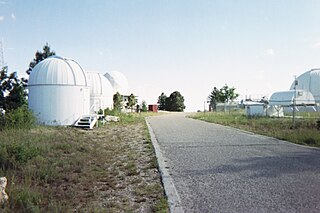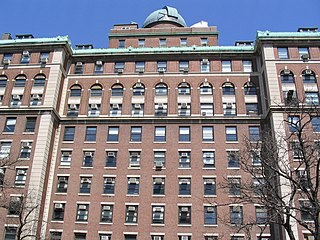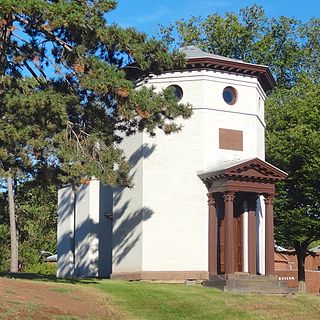
An observatory is a location used for observing terrestrial, marine, or celestial events. Astronomy, climatology/meteorology, geophysical, oceanography and volcanology are examples of disciplines for which observatories have been constructed. Historically, observatories were as simple as containing an astronomical sextant or Stonehenge.

The Vatican Observatory is an astronomical research and educational institution supported by the Holy See. Originally based in the Roman College of Rome, the Observatory is now headquartered in Castel Gandolfo, Italy and operates a telescope at the Mount Graham International Observatory in the United States.

Goldendale Observatory State Park is an educational facility on the northern side of Goldendale, Washington, notable for its unusually large public telescope. The state park occupies five acres (2.0 ha) atop a 2,100-foot (640 m) hill.

The Dunsink Observatory is an astronomical observatory established in 1785 in the townland of Dunsink near the city of Dublin, Ireland.

The Vassar College Observatory is an astronomical observatory of the private Vassar College, located near the eastern edge of the Poughkeepsie, New York college's campus. Finished in 1865, it was the first building on the college's campus, older even than the Main Building, with which it shares the status of National Historic Landmark. The observatory's significance is due to its association with Maria Mitchell, the first widely known woman astronomer in the United States.

Mount Laguna Observatory (MLO) is an astronomical observatory owned and operated by San Diego State University (SDSU). The telescope was operated in partnership with the University of Illinois at Urbana-Champaign (UIUC) until 2000. MLO is located approximately 75 kilometers (47 mi) east of downtown San Diego, California (USA) on the eastern edge of the Cleveland National Forest in the Laguna Mountains on the SDSU Astronomy Campus near the hamlet of Mount Laguna. MLO was dedicated on June 19, 1968, seven years after SDSU's Department of Astronomy became an independent academic department of SDSU's College of Sciences. The dedication took place during the 1968 summer meeting of the Astronomical Society of the Pacific. Currently SDSU is working with University of Kansas (KU), and UNC Chapel Hill on various projects.

Laws Observatory is the name of three separate astronomical observatories owned and operated by University of Missouri from 1880 to the present. Named after former University President Samuel Laws, it is located in Columbia, Missouri (USA).

The Robinson Observatory is an astronomical observatory owned and operated by the University of Central Florida College of Sciences in Orlando, Florida, USA.

Sproul Observatory was an astronomical observatory owned and operated by Swarthmore College. It was located in Swarthmore, Pennsylvania, United States, and named after William Cameron Sproul, the 27th Governor of Pennsylvania, who graduated from Swarthmore in 1891. The 24" telescope was moved from Sproul Observatory to Bentonville, Arkansas in July 2017

Mount Lemmon Observatory (MLO), also known as the Mount Lemmon Infrared Observatory, is an astronomical observatory located on Mount Lemmon in the Santa Catalina Mountains approximately 28 kilometers (17 mi) northeast of Tucson, Arizona (US). The site in the Coronado National Forest is used with special permission from the U.S. Forest Service by the University of Arizona's Steward Observatory, and contains a number of independently managed telescopes.

Rutherfurd Observatory is the astronomical facility maintained by Columbia University named after Lewis Morris Rutherfurd. Initially, Rutherfurd housed its telescopes and equipment in midtown Manhattan and later on the Stuyvesant Estate. When the Morningside campus was built, telescopes were kept in a "transit building" where the Interdisciplinary Science Building now stands. When Pupin Physics Laboratories were completed in 1927, the home of the observatory was moved to the top of the building. Below the Rutherfurd Observatory on the 14th floor was the site of Professor Wallace Eckert's Astronomical Laboratory, in which he constructed the first device to perform general scientific calculations automatically in 1933-34.

Michigan State University Observatory is an astronomical observatory owned and operated by Michigan State University. It is located south of the Michigan State University campus in East Lansing, Michigan (USA), near the corner of Forest Rd and College Rd. It has a Cassegrain telescope in its single dome. Built by Boller and Chivens, the Michigan State University telescope was commissioned in 1969 and entered regular operation in 1970. In 1974, what was at the time a state-of-the-art Raytheon Microcomputer was installed to function as a data gathering and control system. Originally, single channel photoelectric photometry and photography using plates or film were the means of acquiring data. The observatory was closed from 1981 until 1986, at a time when the university was having financial difficulties. It was reopened in the spring of 1986 on the occasion of the return of Comet Halley and has been in regular operation ever since. Since the 1980s, a CCD camera has been employed as the main instrument and the Raytheon computer has been retired. The International Astronomical Union has assigned the MSU Observatory identification code 766.

Smith Observatory was an observatory at Beloit College in Beloit, Wisconsin. Completed in 1882, the observatory was funded by Janette S. Herrick and named in memory of her brother, John F. Smith. It served the campus from 1882 until the 1950s. In 1967, it was used as a coffee house before being torn down in 1969. It was replaced by the Thompson Observatory.

Shattuck Observatory is an astronomical observatory owned and operated by Dartmouth College in Hanover, New Hampshire, United States.

Fuertes Observatory is an astronomical observatory located on the North Campus of Cornell University in Ithaca, New York. The observatory was designed by L.P. Burnham, Cornell Professor of Architecture and completed in fall of 1917. It was originally used by the Civil Engineering Department as an instructional field office for navigation and surveying. Today, the observatory is primarily used for public outreach, welcoming over two thousand visitors per year with open houses on clear Friday nights.

Table Mountain Observatory (TMO) is an astronomical observation facility operated by NASA's Jet Propulsion Laboratory. It is located in Big Pines, California, in Angeles National Forest near Wrightwood, north-northeast of Los Angeles, California, in the United States.

Olin Observatory is an astronomical observatory in New London, Connecticut (USA), owned and operated by Connecticut College. It is part of the F.W. Olin Science Center. The observatory hosts public stargazing events, and is also used for undergraduate instruction.

Three College Observatory (TCO) is an astronomical observatory owned and operated by The University of North Carolina at Greensboro (UNCG), North Carolina Agricultural and Technical State University, and Guilford College (GC). Built in 1979, it is located 10 kilometers (6 mi) south of Graham, North Carolina (USA), in the Cane Creek Mountains. The observatory, designed by W. Edward Jenkins, was funded with a $250,000 grant, however, it would cost $1.5 million to replace it today. The observatory's primary instrument is a 32 in (81 cm) Ritchey-Chrétien reflecting telescope attached to an equatorial mount. It was built by Sigma Research and installed at TCO in 1981. TCO is used by UNCG for instruction and outreach. It continues to be the largest telescope in North Carolina and ones of the largest telescopes in the southeast.

The William Brydone Jack Observatory is a small astronomical observatory on the campus of the University of New Brunswick in Fredericton, New Brunswick. Constructed in 1851, it was the first astronomical observatory built in British North America. The observatory was designated a National Historic Site of Canada in 1954.

The Daniel S. Schanck Observatory is an historical astronomical observatory on the Queens Campus of Rutgers University in New Brunswick, New Jersey, United States, and is tied for the seventh oldest observatory in the US alongside the Vassar College Observatory. It is located on George Street near the corner with Hamilton Street, opposite the parking lot adjacent to Kirkpatrick Chapel, and to the northeast of Old Queens and Geology Hall.

















